
Posted on 08/20/2011 5:18:06 AM PDT by Homer_J_Simpson


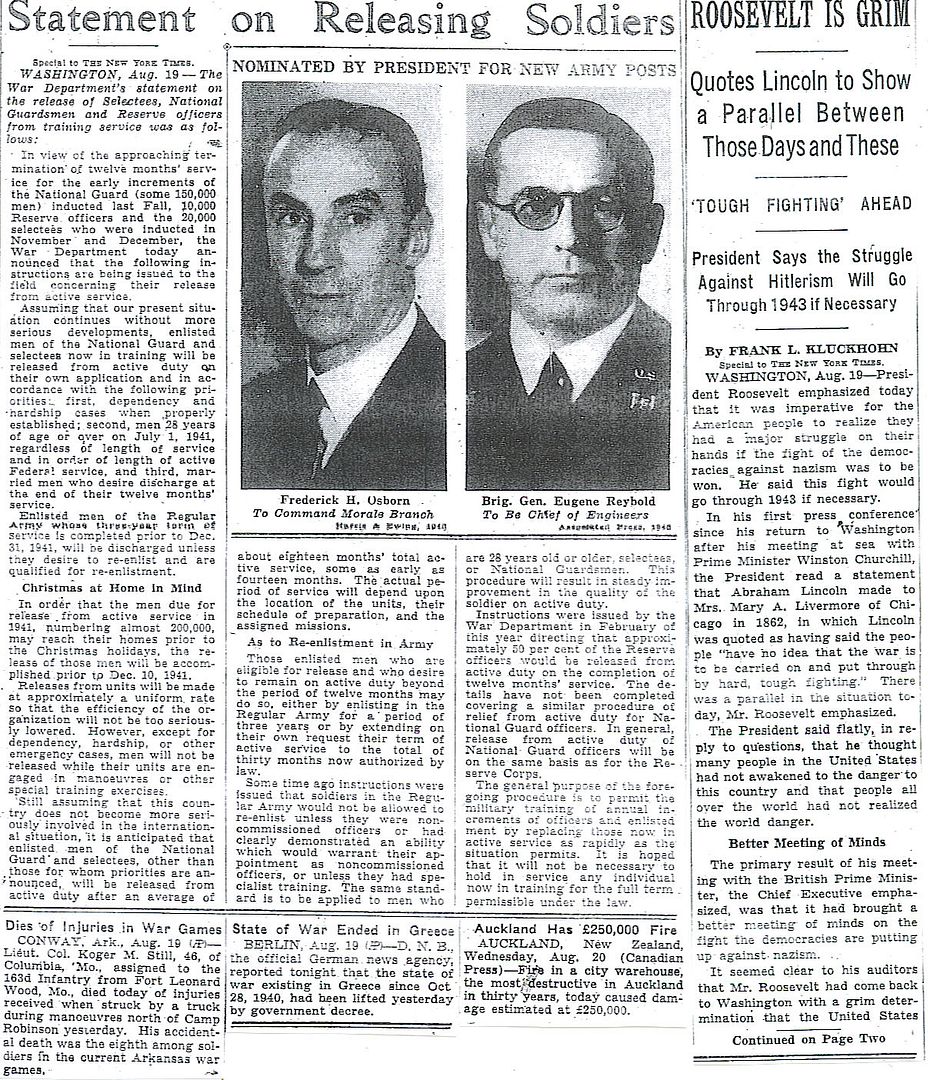


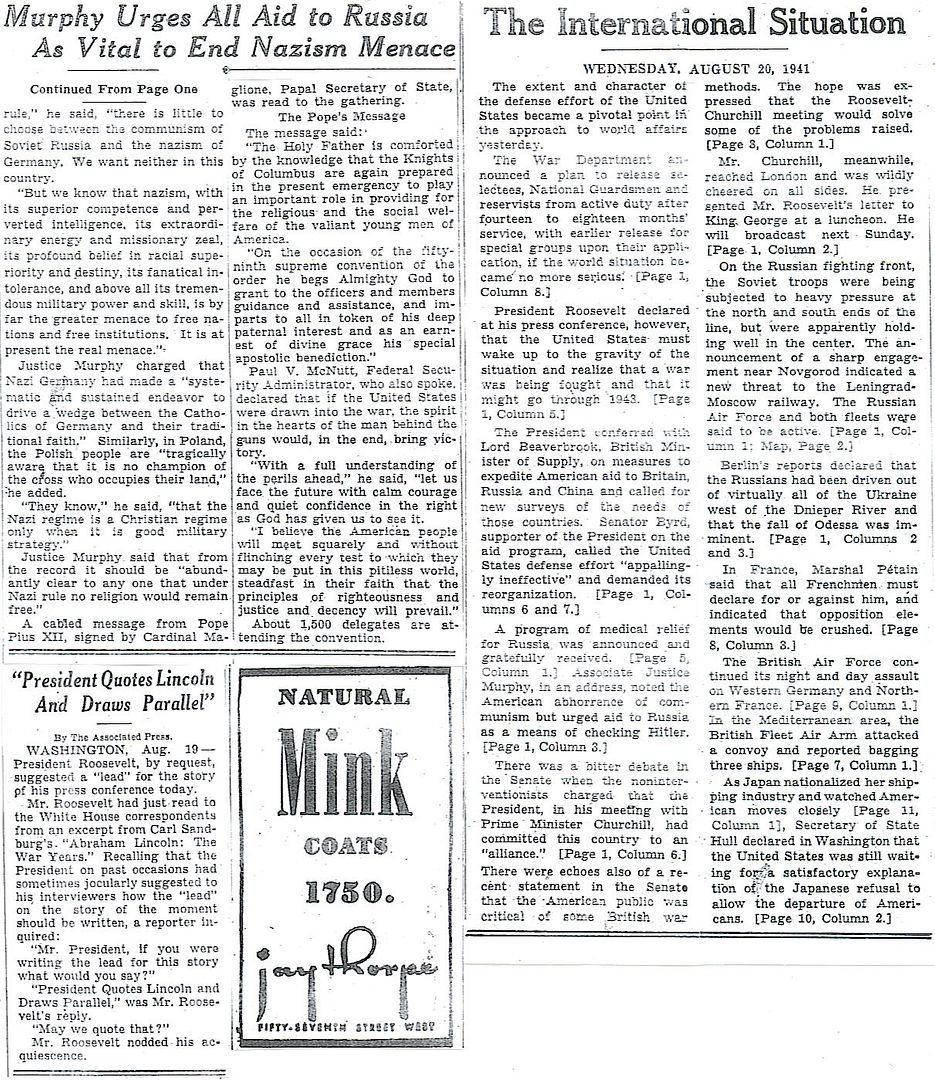

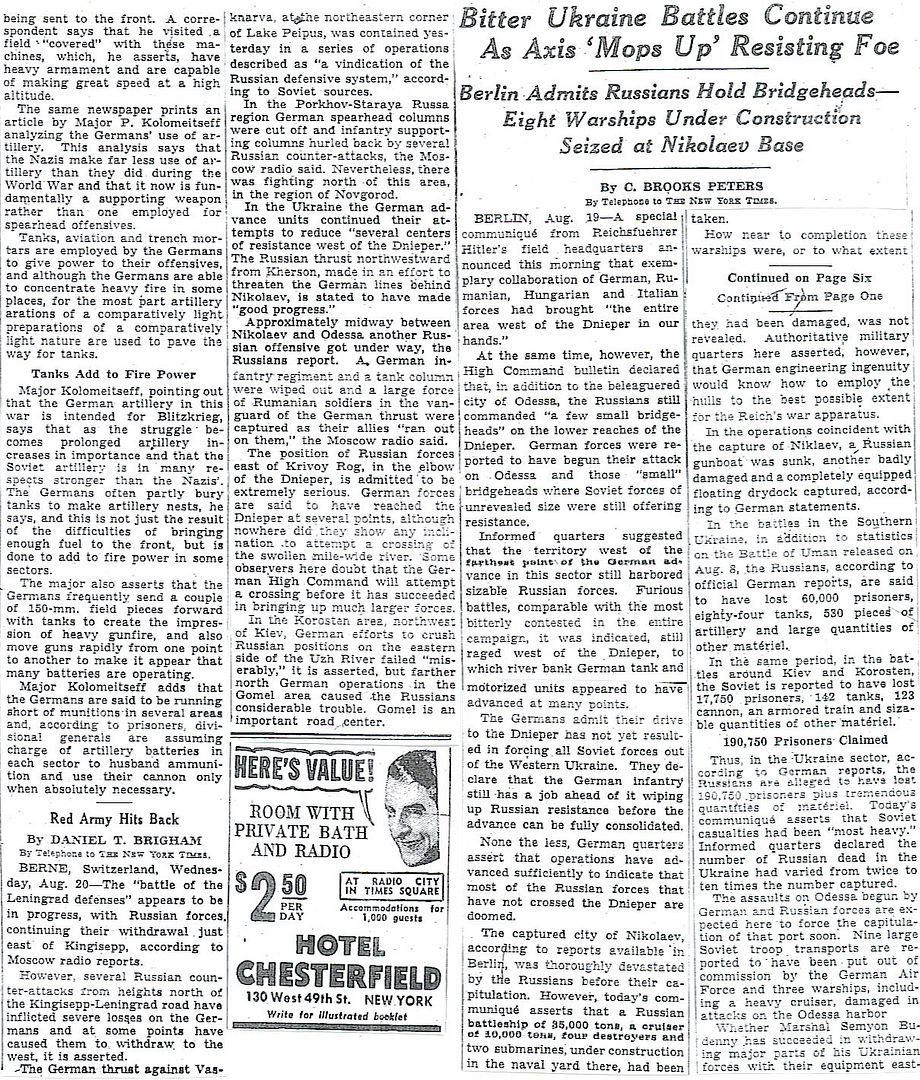

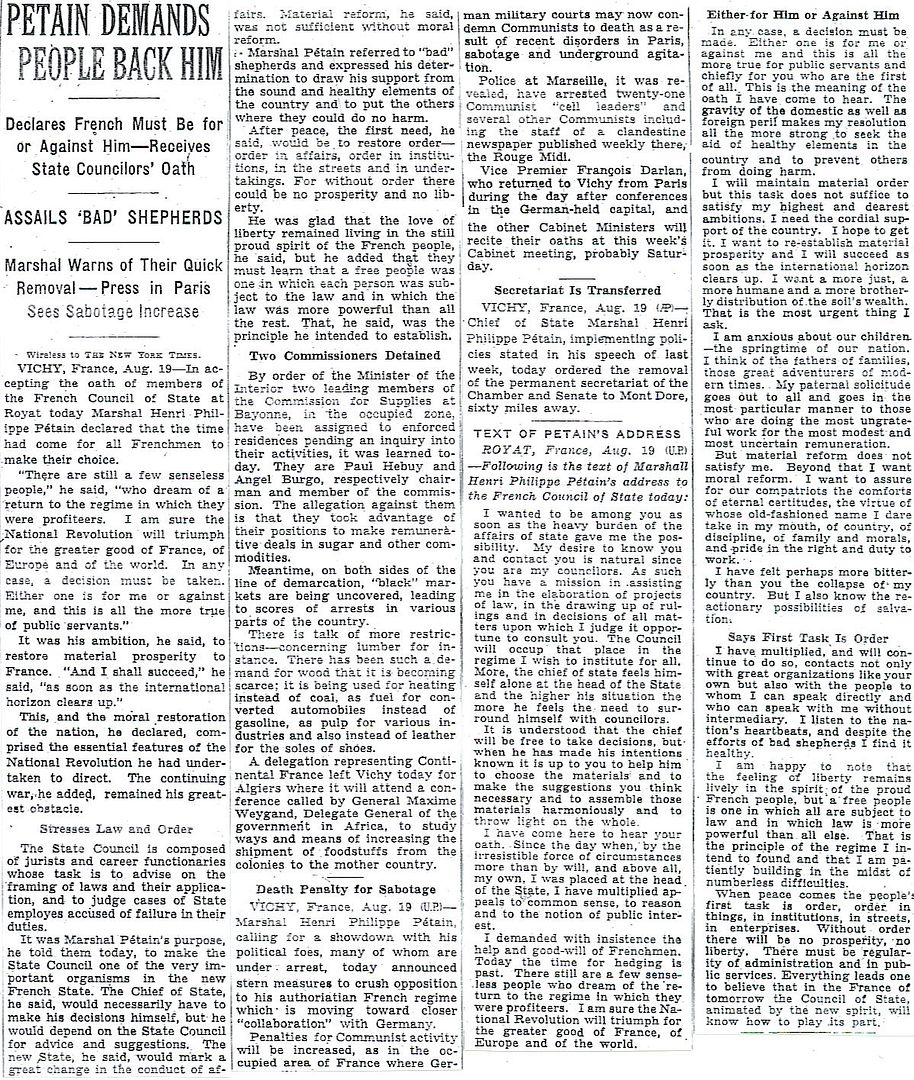

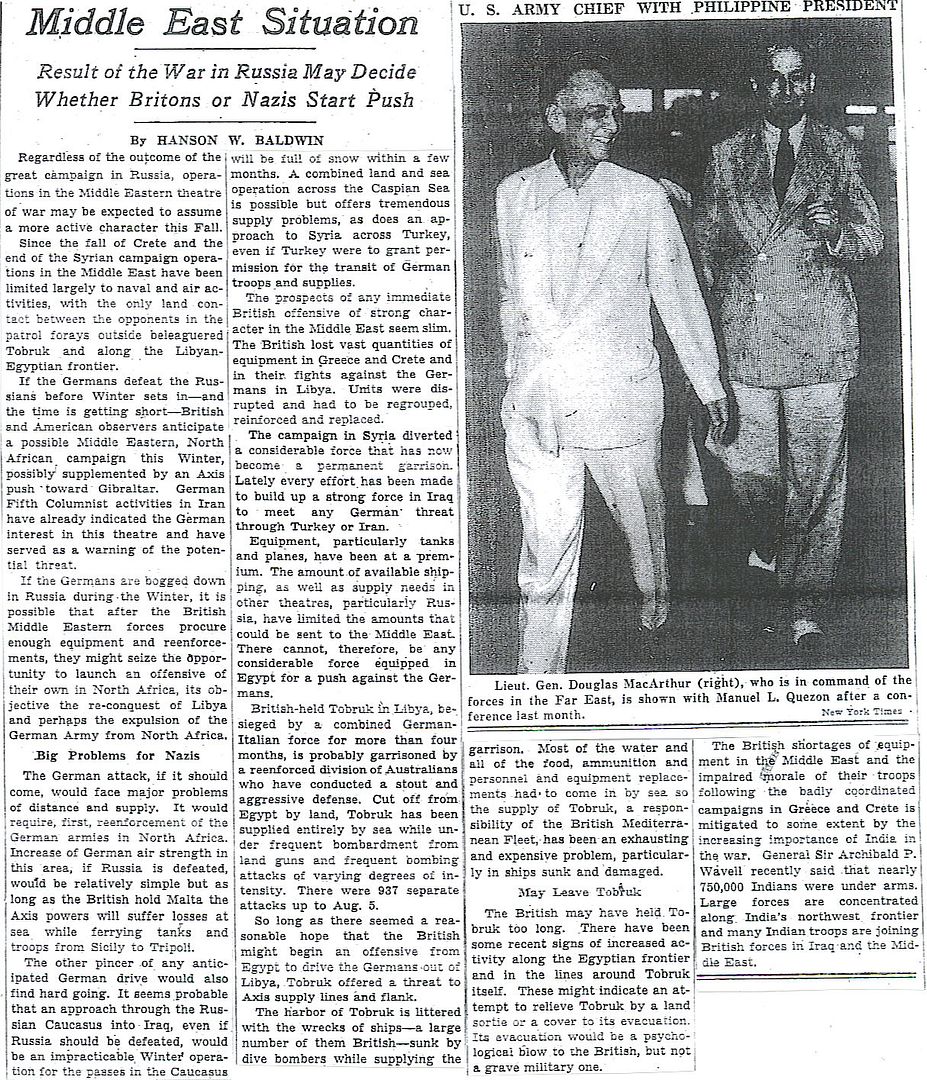
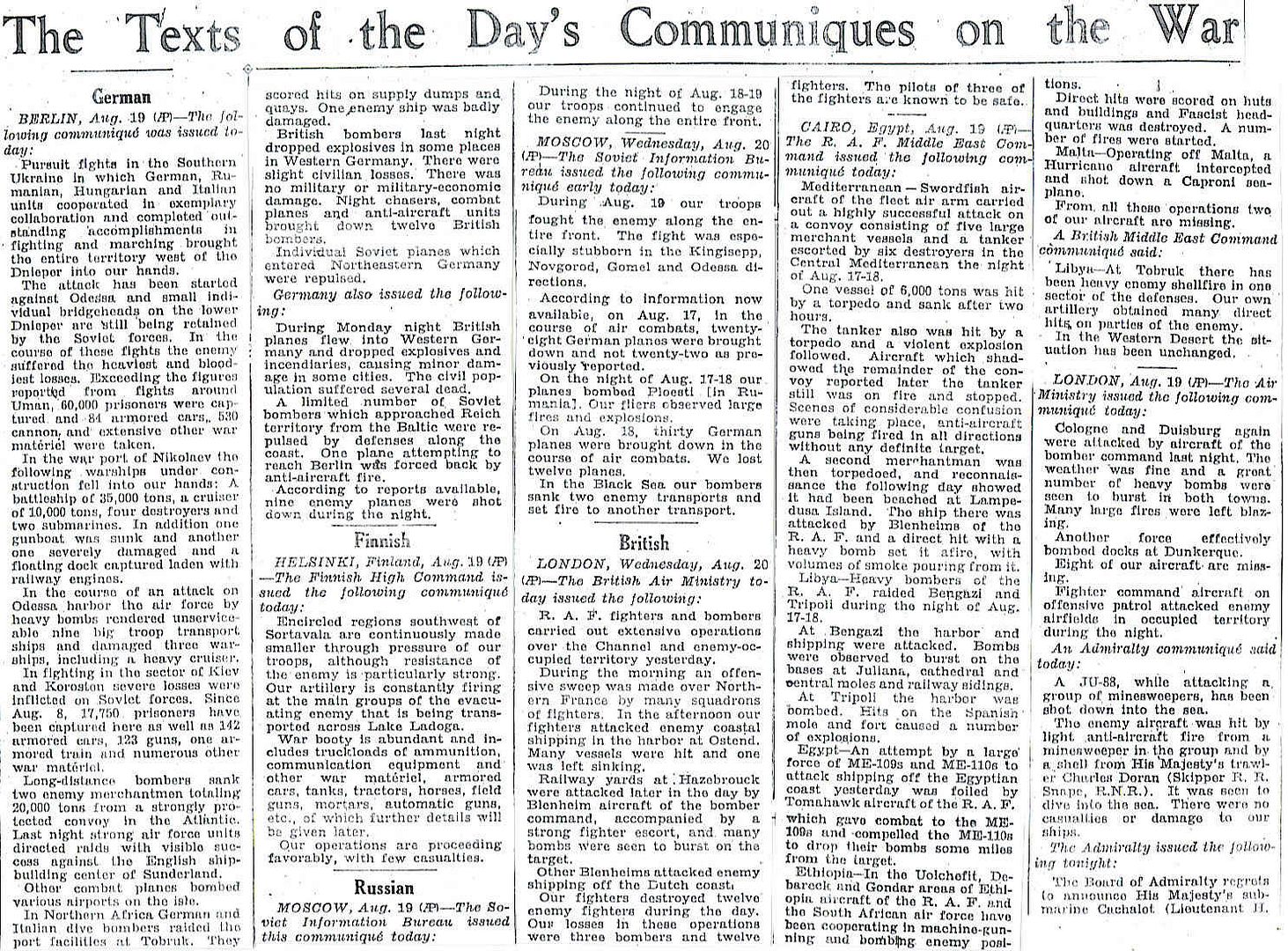

* This page also contains the end of a page one article the beginning of which is not to be found here. Homer regrets the error.
http://www.onwar.com/chrono/1941/aug41/f20aug41.htm
Leningrad citizens to fight to death
Wednesday, August 20, 1941 www.onwar.com
On the Eastern Front... Marshal Voroshilov calls on the citizens of Leningrad to defend their city to the death.
http://homepage.ntlworld.com/andrew.etherington/month/thismonth/20.htm
August 20th, 1941
UNITED KINGDOM: Minesweeper HMS Ilfracombe is commissioned. (Dave Shirlaw)
FRANCE: Paris: 5,000 foreign born Jews are arrested and sent to the deportation camp at Drancy.
50,000 people are arrested in occupied and Vichy France as a hunt goes on for railroad saboteurs. (Jack McKillop)
GERMANY: Adolf Hitler authorizes the development of the V-2 rocket. (Jack McKillop)
U-591 and U-592 are launched. (Dave Shirlaw)
FINLAND: General der Infanterie Waldemar Erfurth, the representative of the OKW at the Finnish Supreme Headquarters, informs Mannerheim that Hitler wishes that the Finns would encircle Leningrad from the north with as many troops as possible. Mannerheim rejects the proposal and says that he has to negotiate with the President and cabinet first. Erfurth gets the impression that the Finns don’t want to have anything to do with Leningrad. (Mikko Härmeinen)
U.S.S.R.: Leningrad: Marshal Voroshilov orders its defenders to fight to the death.
The German 11th Army of Heeresgruppe Süd captures Cherson on the Black Sea, the gateway to the Crimea. (Jack McKillop)
German XXXXII A. K. (Gen. d. Pio. Walter Kuntze) begins an attack on Tallinn. (Jeff Chrisman)
The Red Army, pursuing Stalin’s scorched-earth policy, have blown up the Lenin-Dnieproges Dam at Zaporoje, on the Dnieper, one of the Soviet Unions’ greatest achievements.
The dam was the world’s greatest hydro-electric power complex. Completed in 1932, it was proudly shown to foreign visitors as an example of Communist efficiency, although American engineers designed and built most of it.
It consisted of nearly half a mile of ferro-concrete, and contained huge sluices and docks which enabled cargo ships to pass along the river. The importance of the dam to Soviet industry cannot be over-estimated. The industries of the Dnieper valley, including the iron mines at Krivoi Rog, captured by the Germans, depend on the power it produces. Kharkov, a vital part of the Soviet defence industry, with its tractor works and machine-tool factories, is heavily dependent on the dam’s power. The Russians claim that new factories now coming into operation east of the Urals will compensate for the loss.
This will deprive the Germans of much of the riches of the Ukraine.
At Belaya Tserkov, two German army chaplains informed the First General Staff Officer of the 296th Infantry Division, Lieutenant Colonel Helmuth Groscurth, of the pitiful plight of children brought to their attention by soldiers who had heard them crying in a school in which they had been locked for days without food. At the school, Groscurth was informed by an SS Sergeant that the children were to be shot, as their parents had been. Groscurth arranged for a postponement while he appealed the decision. When he telephoned the staff of Army Group South he was referred to the headquarters of the Sixth Army, from which he elicited a promise that a decision would be sought by evening from the army’s commander.
Reichenau promptly decided that the action should be effectively concluded, but contacted Blobel and ordered it postponed because it had not been properly handled. He directed that the SS-colonel go with a representative of the Sixth Army High Command to Belaya Tserkov the following morning. The next day the children were executed. In a letter to his brother a few months later, Groscurth wrote of Reichenau and his like: “One can’t view the responsible people with anything but the deepest contempt. Because this is so, Germany will be destroyed; I no longer have the slightest doubt of that” (pp. 107-111). (246)
MEDITERRANEAN SEA: On 6 August 1941 HMS P 33 sailed from Malta with orders to intercept an Italian convoy bound for Libya. On 18 August HMS P 32 reported hearing a prolonged depth charge attack that lasted for two hours. When the attack was finally over P 32 attempted to contact P 33 but received no response and it is almost certain that P 33 had perished in the attack. P 33 was reported overdue today when she failed to return to Malta. However the Italians claim that she was sunk by the torpedo boat Partenope off Pantelleria on the 23 August. (Dave Shirlaw)
U.S.A.: In baseball, Larry MacPhail, General Manager of the Brooklyn Dodgers, stages a fashion show before a Ladies Day crowd at Ebbets Field in Brooklyn. Such promotions, as well as the Dodgers pennant race, will push the home gate to over one million fans. (Jack McKillop)
ATLANTIC OCEAN: Minesweeping trawler HMS Lorinda is sunk after a fire near Freetown. (Dave Shirlaw)
“GUARD AND DRAFTEES TO BE RELEASED AFTER 14 TO 18 MONTHS OF SERVICE (8/20/41)”
Are you old enough to have read that headline in August of ‘41?
If so, did anyone believe it back then?
Hey, Dad, how'd that work out for you? You say your Guard unit was Federalized for the duration?
That section is about as good an explanation of why things went so badly at Pearl Harbor and the Philippines.
Everyone new what need to be done. The Congress had appropriated billions of dollars for defense. But, almost two years into the war in Europe and the Army and Navy were still, in many respects, operating on a peacetime footing.
The simple fact of only having 109 B-17s in the summer of 1941 is almost criminal. We easily could have had twice as many had production been put on a war footing a year earlier.
The same with radar, the radars in Hawaii and the Philippines should have been fully staffed and operational, and running from before dawn to after dusk, instead they were still in a training mode. Even had the report of the large blip on the morning of December 7th been acted on by Lt. Tyler, he had no way to properly scramble an intercept. There were no alert aircraft available. And no way for a message to get to them quickly.
Regardless if you were isolationist or interventionist, the fall of France in June of 1940 was a wake up call to the inadequacy of our defenses. It should have stirred a much more rapid reaction than it did. Instead, even after getting billions of dollars, the War and Navy Departments took their time.
The Japanese didn’t.
It was on that very day that Hitler called off all plans against the Soviet capital and ordered the advance into the Ukraine.
It was a dramatic turn of events. Its significance was even greater in view of what was happening in the Kremlin.
On 10th August Stalin received a report from his top agent, Alexander Rado, in Switzerland. Rado claimed to have reliable information that the German High Command intended to let Army Group Centre strike at Moscow via Bryansk. The information certainly was reliable: this had been precisely the plan of the German Army High Command. The effect this report had in Moscow is described in General Yeremenko's memoirs. On 12th August he was instructed by Marshal Timoshenko to come to Moscow at once; he was to take up a new command. Yeremenko writes:
I arrived in Moscow at night and was at once received at the High Command by Stalin and the Chief of the General Staff of the Soviet Army, Marshal Shaposhnikov. Shaposhnikov briefly outlined the situation at the fronts. His conclusion, based on reconnaissance and other information [no doubt Rado], was that on the central sector an attack on Moscow was imminent from the Mogilev-Gomel area, via Bryansk. Following Marshal Shaposhnikov's résumé, I. V. Stalin indicated to me on his map the directions of the main enemy offensives and explained that a new strong defensive front must be built up in the Bryansk area as quickly as possible in order to cover Moscow. At the same time, a new striking force must be created for the defence of the Ukraine.
Stalin then asked Yeremenko where he would like to serve. The argument about this point throws an interesting light on the practices of the Soviet General Staff as well as the manner in which Stalin treated his generals. Here is Yeremenko's account:
I replied, "I am prepared to go wherever you send me."
Stalin regarded me intently and a shadow of impatience flickered across his features. Very curtly he asked, "But actually?" "Wherever the situation is most difficult," I replied quickly. "They are both equally difficult and equally complicated— the defence of the Crimea and the line in front of Bryansk," was his reply. I said, "Comrade Stalin, send me wherever the enemy will attack with armoured units. I believe I can be most useful there. I know the nature and tactics of German armoured warfare." "Very well," Stalin said, satisfied. "You will leave first thing tomorrow morning and start at once on the establishment of the Bryansk front. Yours is the responsible task of covering the strategic sector of Moscow from the south-west. The drive against Bryansk has been assigned to Guderian's armoured group. He will attack with all his might in order to break through to Moscow. You will encounter the motorized units of your old friend with whose methods you are acquainted from the Central Front."
The assurance with which Stalin expounded the plan of Army Group Centre is astonishing if one remembers how badly the Soviet Command had been informed about the German intentions during the first few weeks of the war.
Naturally, the fact that Moscow was within the zone covered by the German offensive plans was obvious even without secret tip-offs. But the German plan of attack might equally well have envisaged a drive down from the north.
Indeed, the High Command Directive No. 34 of 10th or 12th August envisaged this very possibility. Guderian, on the other hand, did not wish to strike via Bryansk, but to drive towards Moscow from the Roslavl area along both sides of the Moscow highway. But the plan of operations submitted to Hitler on 18th August by Colonel-General Halder, Chief of the Army General Staff, as the proposal of the High Command, included the Bryansk area and agreed exactly with what Stalin told Yeremenko on 12th August. Stalin believed in the Bryansk-Moscow operation. He believed in Alexander Rado. He continued to believe in him long after Hitler had overthrown the High Command's plan and ordered Guderian's Panzer Group to turn towards the south.
The stubbornness with which the Soviet Command clung to its idea of Moscow being the objective of the German offensive is reflected in the way in which highly revealing evidence by German prisoners of war and the downright alarming discoveries of Russian aerial reconnaissance were dismissed. Yeremenko writes:
Towards the end of August we took some prisoners who stated under interrogation that the German 3rd Panzer Division, having reached Starodub, was to move to the south in order to link up with Kleist's Panzer Group. According to these prisoners, the 4th Panzer Division was to keep farther to the right and move parallel with the 3rd Panzer Division. This information was confirmed by our aerial reconnaissance on 25th August, when a massive motorized enemy column was discovered moving in a southerly direction.
The prisoners' evidence was correct. They must have been well-informed troops who supplied this dangerous information to the enemy. It was quite true that on 25th August Guderian had ordered his 3rd and 4th Panzer Divisions as well as the 10th Motorized Infantry Division to cross the Desna river in the area of Novgorod Severskiy and Korop. The 17th Panzer Division and 29th Motorized Infantry Division provided flank cover against Yeremenko's divisions in the Bryansk area.
But the Soviet General Staff and Yeremenko believed in an offensive against Moscow. They regarded Guderian's drive to the south as a large-scale outflanking movement. Yeremenko notes: "From the enemy's operations I concluded that with his powerful advanced units, supported by strong armored formations, he was engaged in an active reconnaissance and in a manoeuvre designed to strike at the flank of our Bryansk front."
A fatal error.
Guderian's Panzer divisions pushing to the south did not intend to wheel round towards Moscow, and the 29th Motorized Infantry Division and 17th Panzer Division, which were fighting against Yeremenko's positions in the dangerous, ambush-riddled forests along the road and railway to Bryansk, were not in fact aiming at Bryansk. They were covering Guderian's drive towards the Desna, a drive which was to close the trap behind the Soviet lines at Kiev.
These flank-cover engagements were exceedingly costly. The fierce fighting there is linked with the name of Pochep. There the 167th Infantry Division was involved in heavy defensive fighting. Its 331st Infantry Regiment lost nearly its entire 3rd Company on a single day.
Meanwhile the 3rd Panzer Division, the "Bear" Division from Berlin, was making rapid progress towards the upper reaches of the Desna, a wide, marshy river-course, where Timoshenko had feverishly built up defenses during the past few weeks by press-ganging the civilian population. During the day the German troops drove or fought, and at night they slept by the roadside, under their tanks or inside their lorries. Their objective was not Moscow but the towns of the Northern Ukraine. But the Soviet High Command was blind.
Stalin not only employed his troops in the wrong direction, he did something far worse. He dissolved the Soviet central front with its Twenty-first and Third Armies—the front which formed a barrier across the Northern Ukraine—and placed the divisions under Yeremenko's Army Group for the defence of Moscow. Yeremenko remarks bitterly: "The High Command informed us once more that Guderian's blow was aimed at the right wing of the Bryansk front—in other words, against Moscow. On 24th August Comrade Shaposhnikov notified me that the attack was to be expected within the next day or two."
They waited for it in vain. Yeremenko's account continues:
However, this assumption was not borne out. The enemy attacked in the south and merely brushed against our right wing. At that time neither the High Command nor the command in the field had any evidence that the direction of the offensive of the German Army Group Centre had been changed and turned towards the south. This grave error by the General Staff led to an exceedingly difficult situation for us in the south.
Hitler and Stalin seemed to vie with each other in frustrating the work of their military commanders by fatal misjudgments. So far, however, only Stalin's mistakes were becoming obvious.
The date was 25th August, It was a hot day and the men were sweating. The fine dust of the rough roads enveloped the columns in thick clouds, settled on the men's faces, and got under their uniforms on to their skins. It covered the tanks, the armoured infantry carriers, the motor-cycles, and the jeeps with an inch-thick layer of dirt. The dust was frightful—as fine as flour, impossible to keep out.
The 3rd Panzer Division had been moving down the road from Starodub to the south for the past five hours. Its commander, Lieutenant-General Model, was in his jeep at the head of his headquarters group, which included an armoured scout-car, the radio-van, motor-cycle orderlies, and several jeeps for his staff. The infantrymen cursed whenever the column tore past them, making the dust rise in even thicker clouds.
Model, leading in his jeep, pointed to an old windmill on the left of the road. The jeep swung over a little bridge across a stream and drove into a field of stubble. Maps were brought out; a headquarters staff conference was held on the bare ground. The radio-van pushed up its tall aerials. Motor-cycle orderlies roared off and returned. Model's driver went down to the stream with two field-buckets to get some water for washing. Model polished his monocle. Bright and sparkling, it was back in his eye when Lieutenant-Colonel von Lewinski, CO of 6th Panzer Regiment, came to report. A Russian map, scale 1:50,000, was spread out on a case of hand-grenades.
"Where is this windmill?" "Here, sir." Model's pencil-point ran from the hill with the windmill right across on to the adjoining sheet which the orderly officer was holding. The pencil line ended by the little town of Novgorod Severskiy. "How much farther?" The Intelligence officer already had his dividers on the map. "Twenty-two miles, Herr General." The radio-operator brought a signal from the advanced detachment. "Stubborn resistance at Novgorod. Strong enemy bridgehead on the western bank of the Desna to protect the two big bridges." "The Russians want to hold the Desna line." Model nodded.
Certainly they wanted to. And for a good reason. The Desna valley was an excellent natural obstacle, 600-1000 yards wide. Enormous bridges were needed for crossing the river and its swampy banks. The big road-bridge at Novgorod Severskiy was nearly 800 yards long, and the smaller pedestrian bridge was not much shorter. Both were wooden bridges, and neither of them, according to the division's aerial reconnaissance squadron, had been blown up so far. But they were being defended by strong forces. "We must get one of those bridges intact, Lewinski," Model said to the Panzer Regiment commander. "Otherwise it'll take us days, or even weeks, to get across this damned river." Lewinski nodded. "We'll do what we can, Herr General." He saluted and left.
"Let's go," Model said to his staff. As the main route of advance was congested with traffic the divisional staff drove along deep sandy forest tracks. Through thick woods their vehicles scrambled thirty miles deep into enemy territory. They might find themselves under fire at any moment. But if one were to consider that possibility one would never make any progress at all. From ahead came the noise of battle.
The armored spearheads had made contact with the Russians. Motor-cycle troops were exchanging fire with Russian machine-guns. The artillery was moving into position with one heavy battery. Through his field-glasses Model could see the towers of the beautiful churches and monasteries of Novgorod Severskiy on the high ground on the western bank of the river. Beyond those heights was the Desna valley with its two bridges. Russian artillery opened fire from the town. Well-aimed fire from 15.2-cm. batteries. The artillery was the favorite arm of the Soviets—just as it had been that of the Tsars.
"Artillery is the god of war," Stalin was to say in a future Order of the Day. The plop of mortar batteries now mingled with the general noise. A moment later the first mortar-bombs were crashing all around. Model was injured in one hand by a shell-splinter. He had some plaster put on—that was all. But a shell got Colonel Ries, the commander of 75th Artillery Regiment. He died on the way to the dressing-station.
Low-level attack by Russian aircraft. "Anti-aircraft guns into action!" The enemy's artillery was now finding its range. Time to change position. The 6th Panzer Regiment and the motor-cycle battalion launched their attack that very evening at dusk. But the tanks were held up by wide anti-tank ditches with tree-trunks rammed in. The infantry regiment which was to have attacked the Russians from the north-west at the same moment had got stuck somewhere on the sandy roads. Everything stop! The attack was postponed until the following morning.
At 0500 everything flared up again. The artillery used its heavy guns to flatten the anti-tank obstacles. Engineers blasted lanes through them. Forward! The Russians were fighting furiously and relentlessly in some places, but in others their resistance was half-hearted and incompetent. The first troops began to surrender—men between thirty-five and forty-five, largely without previous military service and with no more than a few days' training now. Naturally they did not stand up to the full-scale German attack—not even with the commissars behind them. German tanks, self-propelled guns, and motorcycle infantry drove into the soft spots.
At 0700 hours First Lieutenant Vopel, with a handful of tanks from his 2nd Troop and with armored infantry-carriers of 1st Company, 394th Rifle Regiment, took up a position north of Novgorod Severskiy. His task was to give support to an engineers assault detachment under Second Lieutenant Störck in their special operation against the big 800-yard-long wooden bridge. First Lieutenant Buchterkirch of 6th Panzer Regiment, who was Model's specialist in operations against bridges, had joined the small combat group with his tanks. Towards 0800 a huge detonation and cloud farther south indicated that the Russians had blown up the smaller bridge.
Everything now depended on Storck and Buchterkirch's operation. Storck and his men in the armoured infantry-carriers took no notice whatever of what was happening to the right or left of them. They shot their way through Russian columns. They raced across tracks knee-deep in sand. Under cover of the thick dust-clouds they infiltrated among retreating Russian columns of vehicles. They drove through the northern part of the town. They raced down into the river valley to the huge bridge. "It's still there!" Buchterkirch called out.
Driver, radio-operator, and gunner all beamed. "Anti-tank gun by the bridge! Straight at it!" the lieutenant commanded. The Russians fled. Second Lieutenant Storck and his men leaped from their armoured carriers. They raced up on to the bridge. They overcame the Russian guard. There, along the railings, ran the wires of the demolition charges. They tore them out. Over there were the charges themselves. They pushed them into the water. Drums of petrol were dangling from the rafters on both sides. They slashed the ropes. With a splash the drums hit the water. They ran on—Storck always in front. Behind him were Sergeant Heyeres and Sergeant Strucken. Corporal Fuhn and Lance-corporal Beyle were dragging the machine-gun. Now and again they ducked, first on one side then on the other, behind the big water-containers and sand-bins. Suddenly Storck pulled himself up. The sergeant did not even have to shout a warning—the lieutenant had already seen it himself. In the middle of the bridge lay a heavy Soviet aerial bomb, primed with a time-fuse.
Calmly Storck unscrewed the detonator. It was a race against death. Would he make it? He made it. The five of them combined to heave the now harmless bomb out of the way. They ran on. Only now did they realize what 800 yards meant. There did not seem to be an end to the bridge. At last they reached the far side and fired the prearranged flare signal for the armoured spearhead. Bridge clear. Buchterkirch in his tank had meanwhile driven cautiously down the bank and moved under the bridge. Vopel with the rest of the tanks provided cover from the top of the bank.
That was just as well. For the moment the Russians realized that the Germans were in possession of the bridge they sent in demolition squads—large parties of 30 or 40 men, carrying drums of petrol, explosive charges, and Molotov cocktails. They ran under the bridge and climbed into the beams. Coolly Buchterkirch opened up at them with his machine-gun from the other side.
Several drums of petrol exploded. But wherever the flames threatened to spread to the bridge squads of engineers were on the spot instantly, putting them out. Furiously, Soviet artillery tried to smash the bridge and its captors. It did not succeed. Störck's men crawled under the planking of the bridge and removed a set of charges—high explosives in green rubber bags. A near-by shell-burst would have been enough to touch them off.
Half an hour later tanks, motor-cycle units, and self-propelled guns were moving across the bridge. The much-feared Desna position, the gateway to the Ukraine, had been blasted open. A handful of men and a few resolute officers had decided the first act of the campaign against the Ukraine. Russia's grain areas lay wide open ahead of Guderian's tanks.
Under a brilliant sunny late-summer sky they rolled southward. Second Lieutenant Störck was just getting a medical orderly to stick some plaster on the back of his injured left hand when General Model's armored command-vehicle came over the bridge. The Second Lieutenant made his report. Model was delighted.
"This bridge is as good as a whole division, Störck."
At the same moment the Russian gunners again started shelling the bridge. But their gun-laying was bad, and the shells fell in the water. The General drove down the bank. Tanks of 1st Battalion, 6th Panzer Regiment, followed by 2nd Company, 394th Rifle Regiment, were moving into the bridgehead. The noise of battle in front grew louder—the plop of mortars and the rattle of machine-guns, interspersed by the sharp bark of the 5.cm. tank cannon of Lieutenant Vopel's 2nd Company. The Russians rallied what forces they could and, supported by tanks and artillery, threw them against the still small German bridgehead. They tried to eliminate it and recapture the bridge of Novgorod Severskiy—or at least destroy it. But Model knew what the bridge meant. He did not need Guderian's reminder over the telephone: "Hold it at all costs!" The bridge was their chance of getting rapidly behind Budennyy's Army Group South-west by striking from the north. If Kleist's Panzer Group, operating farther south, under Rundstedt's Army Group South, pushed across the lower Dnieper and wheeled north, a most enormous pocket would be formed, one beyond the wildest dreams of any strategist.
...To Be Continued....
Hitler Moves East by Paul Carell
"About 4,300 Jews are sent from Paris to Drancy, a transit camp in France.
These are the first of 70,000 Jews who will be deported to Drancy and then to extermination camps, primarily Auschwitz-Birkenau."
"Aided by antisemitic Lithuanian partisans, the SS's mobile killing squads organized Aktionen (actions) against the Jews.
In Kovno, Jews were taken to various forts on the outskirts of town built during Czarist rule.
From there they were organized into groups of 500, marched to huge pits a few miles away, and executed.
Within the first months of German occupation, nearly 40,000 of Kovno's Jews were murdered."
"In August 1941 at Kamenets-Podolski in the Ukraine, members of Einsatzkommandos and local Ukrainian nationalists murdered about 25,000 Jews in huge open pits.
Victims included 5,000 local Jews as well as nearly 20,000 Jews who had been deported from Hungary."
Disclaimer: Opinions posted on Free Republic are those of the individual posters and do not necessarily represent the opinion of Free Republic or its management. All materials posted herein are protected by copyright law and the exemption for fair use of copyrighted works.